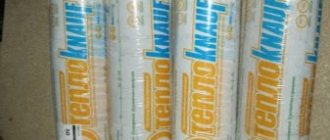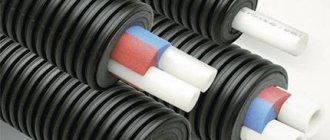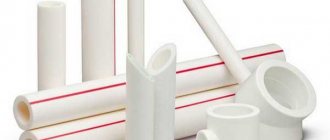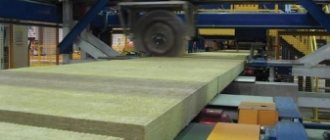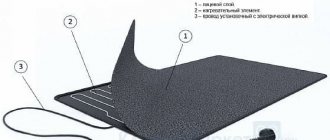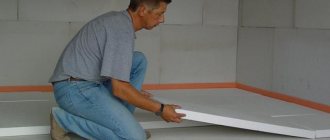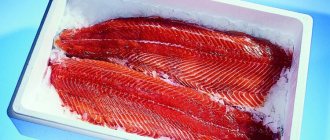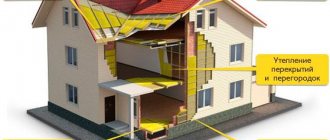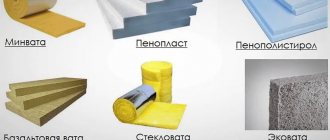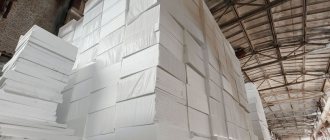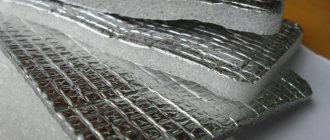Builders widely use foam plastic for heat and sound insulation of private houses, apartments in multi-storey buildings, and large construction projects. They insulate facades, soundproof the walls and ceilings of apartments and houses from the inside, and simultaneously insulate them.
The editors of the StroyGuru portal decided to find out how effective it is to use polystyrene foam for insulation and sound insulation, how to choose the right insulation, what materials and tools are required when carrying out thermal insulation work.
Characteristics
It is difficult to find a person who, at the everyday level, would not come across foam plastic: light white sheets of polystyrene foam foamed using a non-press method (another name is polystyrene).
The material was first obtained in the middle of the twentieth century by polymerizing styropor with the simultaneous introduction of a foaming agent into the molten mixture. The result was a material consisting of 98% air chambers formed by thin polystyrene walls.
Gas, as is known, transfers heat only by convection, which is not the case in foam cells. And along the walls of the chambers, heat transfer is insignificant due to their small thickness. Therefore, the resulting material turned out to be an excellent insulation material.
To identify types of foam, sets of letters and numbers are used. The marking is as follows: PSB-S-25 F, where PSB indicates that this is pressless polystyrene, C is self-extinguishing, 25 is density in kg/m3, F is façade. Instead of the letter “F” or next to it there may be:
- A - regular geometric shape with a smooth edge;
- B - edge with an L-shaped cut;
- R - sheets were cut with a hot string;
- N - can be used for outdoor work.
Polystyrene with printed markings.
During the production process, it is possible to achieve different densities of foam plastic with different indicators of mechanical strength, rigidity, and resistance to various types of impact. Depending on the mass of the material per unit volume (kg/m3), the following grades of insulation are distinguished: PSB-15, PSB-25, PSB-35. Sometimes you can find PSB-50 on sale. But it is used mainly for installing permanent formwork in monolithic construction.
Having different densities, polystyrene foam has different physical and technical characteristics. For clarity, the main characteristics are summarized in Table 1.
Table 1. Main indicators of foam grades.
| Foam grade / Indicators | PSB-S-15 | PSB-S-25 | PSB-S-35 |
| Thermal conductivity, W/(m×°K) | 0.043 | 0.039 | 0.037 |
| Density, kg/m3 | 8,0-15,0 | 15,0-25,0 | 25,0-35,0 |
| Compressive strength, mPa | 0,04-0,05 | 0,08-0,10 | 0.16 |
| Bending resistance, mPa | 0,06-0,07 | 0.18 | 0.25 |
| Flammability class | G3 | G3 | G3 |
| Vapor permeability coefficient, mg/(m*h*Pa) | 0.05 | 0.05 | 0.05 |
| Self-extinguishing time after contact with an open flame, sec | 4 | 1 | 1 |
| Water absorption when immersed in water for 24 hours, % | 4 | 3 | 2 |
In terms of thickness, manufacturers offer sheets from 10 to 100 mm in increments of 10 mm. If necessary, it is possible to obtain foam insulation up to 500 mm thick at any production facility at the same price per 1 m3. The most popular thicknesses among buyers are 40 and 50 mm.
This is explained by the fact that a foam plastic board 5 cm thick has the same heat-saving properties as wood 27 cm thick, brickwork 75 cm thick, or a concrete wall 150 cm thick. This is enough to insulate housing in central Russia. For regions of the Far North, thicker insulation is needed - 10 cm.
There are two standards for length and width: 500 x 1000 and 1000 x 1000. Sometimes you can find a size of 1000 x 2000.
Release forms
The density of the material is the determining factor when dividing foam into grades. It directly affects strength and thermal conductivity. The technical characteristics of individual brands will help determine the scope of use of the material:
- The PSB-S 15 marking belongs to slabs with the lowest density, which is 15 kg per m3. Such expanded polystyrene boards are extremely lightweight and are used for insulating cabins and construction trailers, i.e. in places of temporary residence of people.
- The most popular brand is PSB-S 25, where the density, accordingly, is 25 kg/m3. Scope of application: insulation of building facades, floors, and as roof insulation.
- Polystyrene foam PSB-S 35 has a density of 35 kg per cubic meter. The high technical characteristics of expanded polystyrene with marking 35 are in demand in the production of reinforced concrete structures and sandwich panels.
- Polystyrene foam 50 has an extremely dense structure. Due to this, the slabs are actively used in arranging flooring in refrigerated warehouses and road construction.
Analyzing the tables with technical characteristics, we can conclude that it is advisable to purchase polystyrene foam boards for the purpose of insulating walls with a density of 25 and 35 kg/m3. Moreover, for internal insulation a density of 25 will be sufficient, and for finishing the outside it is better to use foam plastic 35.
When choosing a material for wall insulation, the thickness of the foam matters. It is impossible to give exact recommendations. The choice depends on a number of related factors, which include:
- Climatic conditions of the region where the building is located.
- Material used to construct walls. Often the walls of a building consist of several layers, differing in their technical characteristics. Therefore, it is necessary to determine the total indicator.
- The density of the polystyrene foam board, which is determined by the marking.
Usually, due to a combination of factors, if it is necessary to insulate internal walls, 50 mm foam plastic is used; the use of 100 mm foam plastic is more in demand for external work.
Advantages and disadvantages
Polystyrene foam has both strengths and weaknesses. The advantages are obvious:
- low thermal conductivity - 0.037-0.041 W/(m K), comparable to mineral wool, which makes it possible to effectively insulate building structures made of brick, concrete, expanded clay concrete, gas silicate blocks, etc.;
- ability to maintain performance properties over a wide temperature range: from -50oC to +75oC (if there is no contact with an open flame, it begins to deteriorate at +160oC);
- low cost - refers to the budget type of materials;
- simple installation - there is no need to install the sheathing, as it is fixed with adhesive;
- does not require work experience or special tools when carrying out thermal insulation;
- low specific gravity - does not create a load on the structural elements of the building;
- does not serve as a base for the proliferation of mold and mildew;
- exhibits inertness to the components of cement-sand mortar, gypsum, and weak acids.
disadvantages , but consumers pay little attention to them. Among the disadvantages:
- flammability - class G3 (normally flammable). Clarification is necessary here: manufacturers claim that the insulation is self-extinguishing due to special additives - fire retardants, as indicated by the marking with the letter “C” (see photo above). However, this property is demonstrated during experiments only by products of well-known brands: Nova Chemicals, BASF, Polimeri Europa and Styrochem. Russian manufacturers also introduce fire retardants into the composition, but do not achieve a self-extinguishing effect: the products burn well;
The foam with the cladding is burning.
- release of toxic substances during combustion (hydrocyanic acid, phosgene, hydrogen bromide, etc.), as a result of which a person quickly loses consciousness and dies during a fire;
- transition to a fluid phase during the combustion process - spreads across the floor, increasing the area of the fire;
- release of styrene, which is harmful to health, when the temperature rises above +30oC;
Attention: is polystyrene foam harmful as insulation indoors? In the absence of extreme (high temperature) or force majeure circumstances (fire), foam insulation is absolutely harmless to humans, which cannot be said in the event of an emergency situation.
- short service life - 5-7 years, during which the original thermal conductivity values are maintained, although manufacturers claim the opposite, talking about 30 years or more. Laboratory tests, during which a foam plastic slab that had served for 9 years was removed from the wall, showed that due to destructive processes (the appearance of shells, cavities, increased density and decreased volume), the thermal conductivity coefficient increased almost 8 times;
- amplifies (resonates) indoor noise. Explanations are also needed here, since on the Internet, including Wikipedia, it is stated that polystyrene foam has good soundproofing properties. But this is a myth. The insulation has a closed cell structure and is light weight. Therefore, it cannot reflect sound waves - there is no mass and absorb noise - the material does not allow air to pass through. On the contrary, the high rigidity of the plate and low mass lead to the occurrence of resonance in the region of 500 Hz, i.e. in the very center of household noise;
- instability to most paint solvents - melts instantly;
- ages intensively under ultraviolet radiation (sun rays), which is intensely hushed up by manufacturers and sellers;
- lack of vapor permeability, although all reference books provide digital values that refute this statement. The problem is solved either by the correct choice of material thickness, which requires complex calculations, or by installing a ventilated facade and roof;
- low mechanical strength - easily damaged during transportation, installation and operation.
The foam was damaged by a falling branch.
Particular attention should be paid to the relationship between the insulation and mice - if they are found in the house, then first of all the damage will be caused to the foam plastic.
The mice did their best.
Comparison with other popular insulation materials
Foam plastic has been used for wall insulation for a long time and often.
Everyone understands that an article can be written about any material, where its advantages will be exaggerated and its disadvantages will be minimized. To avoid creating such an impression, you should speak in the language of numbers.
As you can see in the photo, PPS does not support combustion and goes out.
I propose to compare the main indicators of the most popular insulation materials:
| Material | Thermal conductivity | Density | Vapor permeability |
| PSB-S | 0.038 W/m*K | 40 kg/m³ | 0.05 mg/m*h*Pa |
| PSB-S | 0.041 W/m*K | 100 kg/m³ | 0.05 mg/m*h*Pa |
| PSB-S | 0.050 W/m*K | 150 kg/m³ | 0.05 mg/m*h*Pa |
| Mineral wool | 0.048 W/m*K | 50 kg/m³ | 0.6 mg/m*h*Pa |
| Mineral wool | 0.056 W/m*K | 100 kg/m³ | 0.56 mg/m*h*Pa |
| Mineral wool | 0.07 W/m*K | 200 kg/m³ | 0.49 mg/m*h*Pa |
| Foam glass | 0.07 W/m*K | 200 kg/m³ | 0.03 mg/m*h*Pa |
| Polyvinyl chloride foam | 0.052 W/m*K | 125 kg/m³ | 0.23 mg/m*h*Pa |
| Extruded polystyrene foam | 0.036 W/m*K | 45 kg/m³ | 0.021 mg/m*h*Pa |
| Polyurethane foam | 0.035 W/m*K | 60 kg/m³ | 0.08 mg/m*h*Pa |
| Expanded clay | 0.1 W/m*K | 200 kg/m³ | 0.26 mg/m*h*Pa |
Insulation for walls and floors is foam glass.
Structure of foamed PVC.
Polyurethane foam has a lower thermal conductivity coefficient than EPS, but is much more expensive.
Analysis of the table allows us to conclude that foam plastic remains one of the most effective materials for thermal insulation . It is lightweight, practically does not allow heat to pass through, is easy to use and relatively cheap.
As for the harm of styrene, allegedly released by PPS during low-temperature destruction, this is all fiction, not supported by any scientific data.
Dishes made of polystyrene.
Suffice it to recall polystyrene foam dishes, toys, packaging and many other different products with which we constantly come into contact in everyday life, and at the same time, the planet’s population continues to grow.
Furniture toy filled with polystyrene granules.
Extension cords are also made from polystyrene.
I don't want to say that polystyrene is absolutely harmless. Living in general is harmful. It all depends on the quality, conditions of use, and compliance with the manufacturer’s instructions for a particular product. But the harm of polystyrene foam as insulation is clearly exaggerated; apparently, it is beneficial for someone.
Insulation of the roof with special blocks made of PSB-S.
Which is better - polystyrene foam or polystyrene foam?
Among specialists and home craftsmen, disputes often arise about what is better to use for insulation: polystyrene foam or expanded polystyrene. Advanced portal visitors will say that these are one and the same. And they will be right. Indeed, from the point of view of a chemist, expanded polystyrene (aka styrofoam) is not only a classic representative of foam plastics, but also the founder of the class of foamed plastics.
At the household level, not everything is so simple, since expanded polystyrene is associated with materials such as Penoplex, TechnoNIKOL, Styrofoam, URSA, which in structure are almost indistinguishable from polystyrene foam, but are made from extruded polystyrene foam. It’s easy to figure out where the foam insulation is and where the extruded polystyrene foam is: the first is always white, the second is colored (painted). Moreover, each manufacturer uses its own color scheme: TechnoNIKOL (yellow), Penoplex (orange), Styrofoam (blue), etc.
When it comes to their performance characteristics, there are differences, but they are minor:
- Polystyrene foam has a higher thermal conductivity, which requires a thicker layer of thermal insulation. And this is the loss of usable area of the room when insulating from the inside;
- extruded polystyrene foam has higher strength and rigidity;
- polystyrene foam costs much less (approximately 2,000 rubles/m3 versus 4,500 rubles/m3).
Slab size
Foam boards are produced mainly in three sizes: 0.5 * 1, 1 * 1 and 2 * 1 m. It is immediately worth noting that this insulation is easy to cut, so no problems should arise during the installation process. So, it is better to choose the material that is most suitable for the area of the insulated surface. As a rule, for insulating balconies, loggias and apartments in apartment buildings, the choice is made on slabs measuring 0.5 * 1 m : they are most convenient to work with, they are more economical, and it will be easier to insulate all kinds of complex facade details with such material. But if you need to insulate a private house, the walls of which have a regular flat surface, then it makes sense to use slabs measuring 1 * 1 m. The largest material, slabs measuring 2 * 1 m are used least often for particularly large buildings.
Application area
Foam insulation can be found in various sectors of the national economy. They are used, for example, for thermal insulation of freezers, refrigerators, isothermal vans, etc. In construction they use for insulation:
- facades, which allows you to solve several problems at the same time: create effective thermal insulation of the building; protect walls from rain, wind, sunlight and temperature changes; remove the “dew point” from the thickness of the wall, preventing it from freezing (very important for brick and ceramics);
- floors - used for insulation using the “floating screed” method;
- roofs (roofs) - laid on the back side of the roof (“Ventilated roof”) and on top (“Non-ventilated roof”);
- foundations;
- ceiling (interfloor ceiling);
- walls from the inside of the premises, balconies, loggias, garages, workshops and other utility or utility rooms;
- pipelines.
Foam plastic is also increasingly used in the installation of permanent formwork during the construction of monolithic buildings.
Basic parameters
The basis of the insulation is a polymer compound called polystyrene. Its production involves pre-foaming polymer granules and pressing them at elevated temperature and pressure. As a result, each grain contains more than 95% air; during the pressing process, its shell melts and fuses with neighboring granules.
When molding the material, a slight pressure is applied, ensuring only a tight contact of the grains. That is why a significant amount of air remains in its structure, acting as a heat insulator.
Thanks to its granular structure, polystyrene foam has unique properties. Each granule is closed, which ensures complete inertness of the material, and the presence of gas cavities provides excellent thermal insulation properties.
Manufacturers and prices
Construction foam is produced in all regions of Russia, since it is very expensive to deliver outside the region or region. Therefore, there is no point in talking about specific supplier companies. Prices for 1 m3 vary within 1790 rubles. for PSB-S-15 insulation up to 3900 rubles. for PSB-S-50.
A number of foreign enterprises also supply their products to Russian markets. Some from their factories outside the Russian Federation, some from production facilities located in Russia. Among them:
- BASF is a German company with branches in Russia;
- Polimeri Europa (Dunastyr) (Italy);
- "Styrochem" (Finland), etc.
Prices for products from foreign companies are 10-85% higher with the same performance characteristics, with the exception of flammability. Imported polystyrene foam does not burn and goes out, but Russian foam does not burn.
Foundation thermal insulation
Insulating the foundation with polystyrene foam requires enhanced protection, since not only does soil pressure occur, but also the load on the foam plastic increases in winter during soil heaving, and this occurs during freezing. Strong reinforcement is required; for this, brickwork is done or concrete is poured.
Insulation of the foundation with polystyrene foam. Photo – plaforamaconstruye.com
Insulation technology
Any novice craftsman who is familiar with the basics of thermal insulation work can insulate a house with polystyrene foam. To work, you will need to purchase materials and assemble a set of tools.
Tools and materials
Consumables you need to buy:
- Styrofoam;
- cement or synthetic based adhesive;
- special mushrooms for attaching foam plastic, the length exceeding the thickness of the slabs by 4-5 cm - needed when insulating vertical and inclined surfaces;
- reinforcing mesh;
- polyurethane foam.
The toolkit includes:
- level;
- plumb line;
- roulette;
- a knife with a replaceable blade or a hacksaw;
- electric drill;
- glue container;
- mixer attachment for mixing glue.
A universal set of tools for all structural elements of the house. Technologies for insulating roofs, floors and walls from the outside and inside have their own nuances. Therefore, we will consider separately.
façade
Insulation of the wall outside the building is carried out in several steps.
Step 1. The wall is dust-free.
Step 2: Apply a layer of penetrating primer;
Step 3. At the junction of the wall with the foundation or at a height of 50 cm from the ground along the perimeter of the building, a profile for insulation is attached - it serves as a support for the bottom sheets of foam plastic.
Scheme of fastening the profile to the wall and in the corners of the building.
Step 4. Mix the glue with a drill and mixer.
Step 5. The adhesive mixture is applied to the insulation boards. There are several methods of application: in a continuous layer, in 5 points (in the corners and in the middle), in stripes around the perimeter and in the center, in stripes or dots.
Glue is applied.
Step 6. The foam sheet is placed on the profile and then pressed against the wall surface. In the pressed position, you need to fix the insulation for a few seconds for the glue to set. Excess glue that appears is removed with a spatula.
Step 7. 2 rows of insulation are attached.
The next row is attached.
Step 8. Holes for fungi are drilled in the wall using a drill (perforator). There are five for each sheet: in the corners and in the center.
Step 9. Additional fastening of foam sheets to the wall is carried out. First, fungi are inserted into the holes, then they are fixed with plastic dowels.
Fungi are inserted into the holes.
The fungus is fixed with a dowel.
Step 10. Reinforcing mesh is glued.
The surface of the heat-insulating layer is reinforced with reinforcing mesh.
The further progress of work is determined by the type of finishing. Decorative plaster is applied to the reinforcing mesh. The sheathing is placed under the siding.
Paula
Floor insulation is carried out under the screed and along the joists. Thermal insulation under the screed is carried out in several stages:
- the base of the floor is being prepared. Full information about the technology for preparing the subfloor is given in the work “Preparing the floor for pouring screed”;
- waterproofing work is being carried out;
- Foam boards are laid tightly next to each other. Adjacent rows are mounted staggered, “staggered” - the transverse seams should not coincide. Here you need to pay attention to several points: the sheets are fixed with glue, there should be a technological gap of 1-2 cm between the wall and the insulation, the joints between the plates are glued with tape, the cracks are sealed with adhesive putty;
Floor insulation.
- the insulating layer is reinforced;
- the screed is poured.
The algorithm for floor insulation on joists is as follows:
- the floor base is being prepared;
- The subfloor is being waterproofed - details can be found in the material “Waterproofing a wooden floor”;
- logs are attached;
- foam is laid;
- the gaps between the joists and the insulation are foamed with polyurethane foam;
- the thermal insulation layer is covered with a vapor barrier film;
- plywood or OSB sheets are attached to the joists;
- finishing floor is installed.
Walls from the inside
You can insulate walls from the inside using 2 technologies:
- for glue for decorative plaster, painting or “liquid” wallpaper;
- using lathing, if the finishing is ceramic tiles or PVC panels.
Attention: builders have recently abandoned lathing altogether, replacing gypsum plaster with gypsum plaster for wallpaper and paint.
In the second case, the foam is glued to the wall between the vertical posts. The gaps between the insulation boards and the frame are foamed. On top of the insulation, sheets of plasterboard are attached under ceramic tiles or a counter-lattice is placed under PVC panels.
Roofs
The roof is insulated with foam plastic in 2 ways, depending on the type of roof.
- A horizontal (flat) roof is covered with insulation boards 7-10 cm thick on top, after which it is filled with bitumen and glued with two layers of roofing felt.
- The pitched roof is insulated from the rear side, in relation to the attic space. The slabs, 10 cm thick, are attached to the lathing, mounted on the flooring under the foam. Here it is important to properly perform a vapor barrier and create a ventilation gap between the roof and the insulation to avoid the formation of condensation.
Impact on human health
Often when choosing insulation, the question arises of how harmful it is for the inhabitants of the house. This polymer is not subject to chemical or biological corrosion, and therefore does not emit harmful substances over time.
Despite the inertness of the material, over time the foam ages, undergoing gradual destruction. Even in this case, it is not harmful to human health, because styrene polymers are rarely completely destroyed; only the cross-linking between individual macromolecules disintegrates.
With proper use, the shelf life of insulation reaches several decades. Its aging begins only after 40–50 years and continues for quite a long time.
The only negative effect of polystyrene foam is its low vapor permeability, therefore, to maintain a normal microclimate in the room, forced ventilation must be installed.
The excellent technical characteristics of polystyrene foam, safety for humans and animals, as well as low cost have ensured its high popularity as insulation.
Elasticity
Plasticity is an additional advantage of the material. Elastic insulation can be mounted on uneven walls and on complex-shaped facades.
Mineral wool is characterized by high plasticity. Loose flexible material takes the shape of any surface. If we compare basalt wool and quartz-based thermal insulation, the second is more flexible. Mineral wool is especially elastic in rolls, not in slabs - they are denser and stiffer.
Polystyrene foam is not elastic; it is rarely used for insulating facades of complex shapes. It is suitable for thermal insulation of a flat, even surface (if there are uneven surfaces on the wall, the insulation will not fit tightly to it).
Conclusion: mineral wool is elastic, foam plastic is not.

